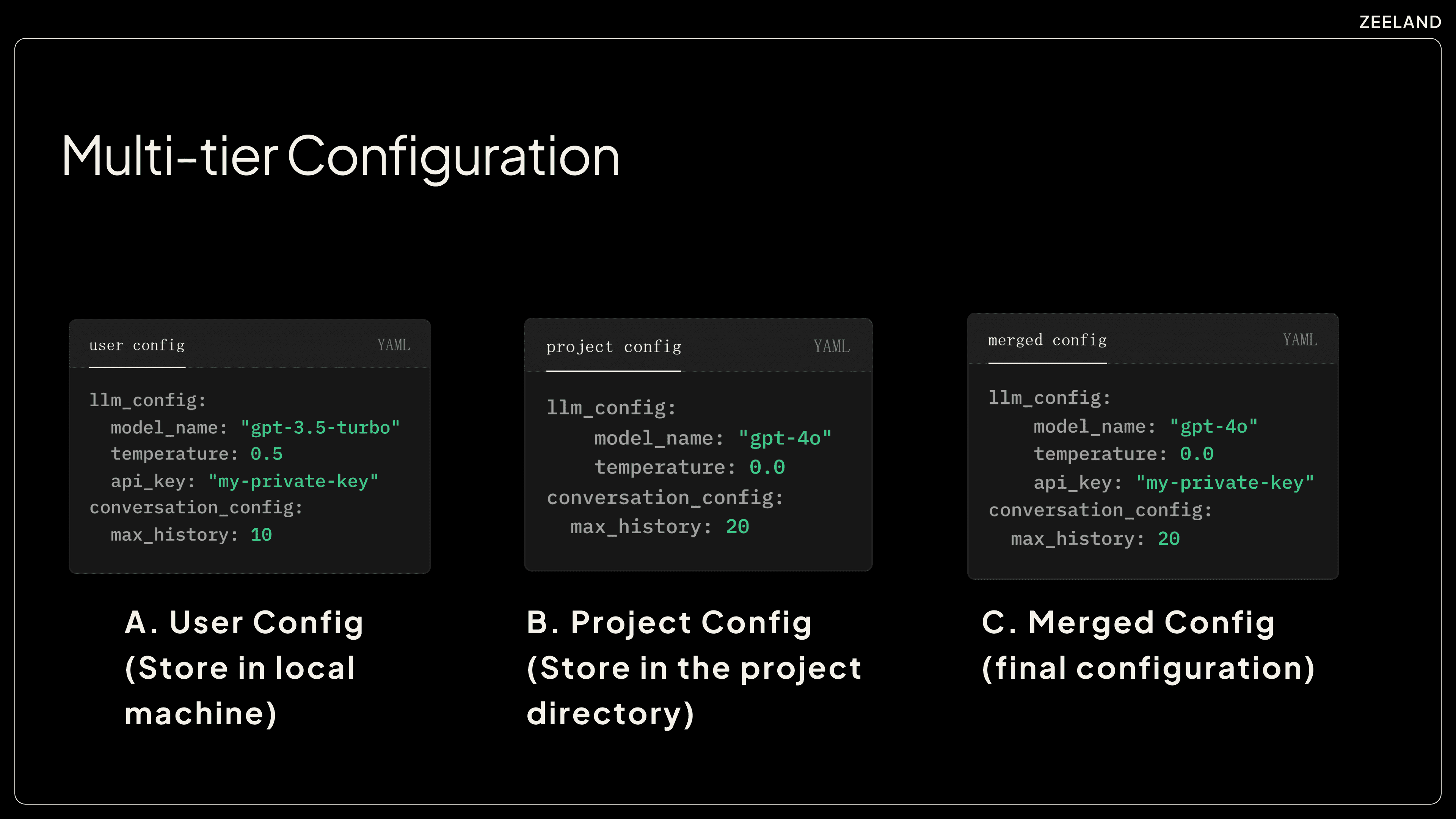
What is Conftier?
Conftier is a powerful multi-tier configuration management framework that simplifies the definition, access, and synchronization of layered configurations in Python applications.
Think of VSCode's configuration system: you have user settings that apply globally and workspace settings that override them for specific projects. Conftier brings this same intuitive model to your Python frameworks and applications.
# Define your configuration schema with Pydantic
class LLMConfig(BaseModel):
model_name: str = "gpt-4"
api_key: str = ""
temperature: float = 0.7
# Access the merged configuration
config = config_manager.load()
model_name = config.llm_config.model_name # Automatically picks the highest priority valueWhy Conftier?
The Problem
Have you ever faced these challenges in your Python applications?
- Global vs. Local Settings: Users want their preferences everywhere, but projects need specific overrides
- Configuration Complexity: Managing multiple YAML files, ENV variables, and command-line arguments
- Type Safety: Dealing with string values when you need integers, or missing required settings
- Documentation: Explaining to users what configuration options are available and where to set them
Here's a familiar example:
# User's global preferences (~/.myapp/config.yaml)
theme: "dark"
editor:
font_size: 14
tab_width: 2
# Project-specific settings (./project/.myapp/config.yaml)
editor:
tab_width: 4 # Override just this value for this project
debug: true # Project-only settingConftier makes this pattern easy to implement in your Python applications.
Real-World Use Cases
AI Framework Configuration
# Define schema once
class OpenAIConfig(BaseModel):
api_key: str = ""
model: str = "gpt-4"
temperature: float = 0.7
# Users set their API key globally
# ~/.zeeland/myai/config.yaml
api_key: "user-api-key-123"
# Projects override the model
# ./.myai/config.yaml
model: "gpt-3.5-turbo"CLI Tool Settings
# Default tool settings
@dataclass
class ToolConfig:
output_format: str = "json"
verbose: bool = False
cache_dir: str = "~/.cache/mytool"
# User's preferred CLI experience (applies to all projects)
# ~/.zeeland/mytool/config.yaml
output_format: "yaml"
verbose: true
# Project-specific needs
# ./.mytool/config.yaml
output_format: "csv" # This project requires CSV outputWeb Framework Configuration
# Database connection defaults
class DBConfig(BaseModel):
host: str = "localhost"
port: int = 5432
username: str = ""
password: str = ""
pool_size: int = 10
# Development environment (user config)
# ~/.zeeland/mywebapp/config.yaml
host: "localhost"
username: "dev_user"
password: "dev_password"
# Production deployment (project config)
# ./.mywebapp/config.yaml
host: "production.db"
port: 5433
pool_size: 25
Key Features
Multi-level Configuration Management: Like VSCode's user/workspace settings, handle default, user-level, and project-level configurations.
Flexible Schema Definition: Use Pydantic models for validation or simpler dataclasses - your choice.
Priority Mechanism: Project settings override user settings, which override defaults.
Type Safety: No more string/int confusion or missing required fields - everything is validated.
Smart Merging: Only override what's specified, preserving all other values.
CLI Integration: Add configuration commands to your CLI tools with a single function call.
IDE Autocompletion: Full type hints for a great developer experience.

When to Use Conftier
Conftier shines when:
You're building a framework or library: Give your users a consistent way to configure your tool.
Your app has both user preferences and project settings: Like VSCode, where some settings are personal and others are project-specific.
You need schema validation: Ensure configuration values are the correct types and within valid ranges.
You want to reduce boilerplate: Stop writing the same configuration loading code in every project.
Benefits at a Glance
| Without Conftier | With Conftier |
|---|---|
| Manual parsing of multiple config files | Automatic loading and merging |
| Type errors discovered at runtime | Validation at load time |
| Custom code for merging configs | Smart merging built-in |
| Documentation struggles | Schema serves as documentation |
| Repetitive boilerplate | Consistent, reusable pattern |
Ready to get started? Head to the Quick Start Guide to begin using Conftier in your projects.
